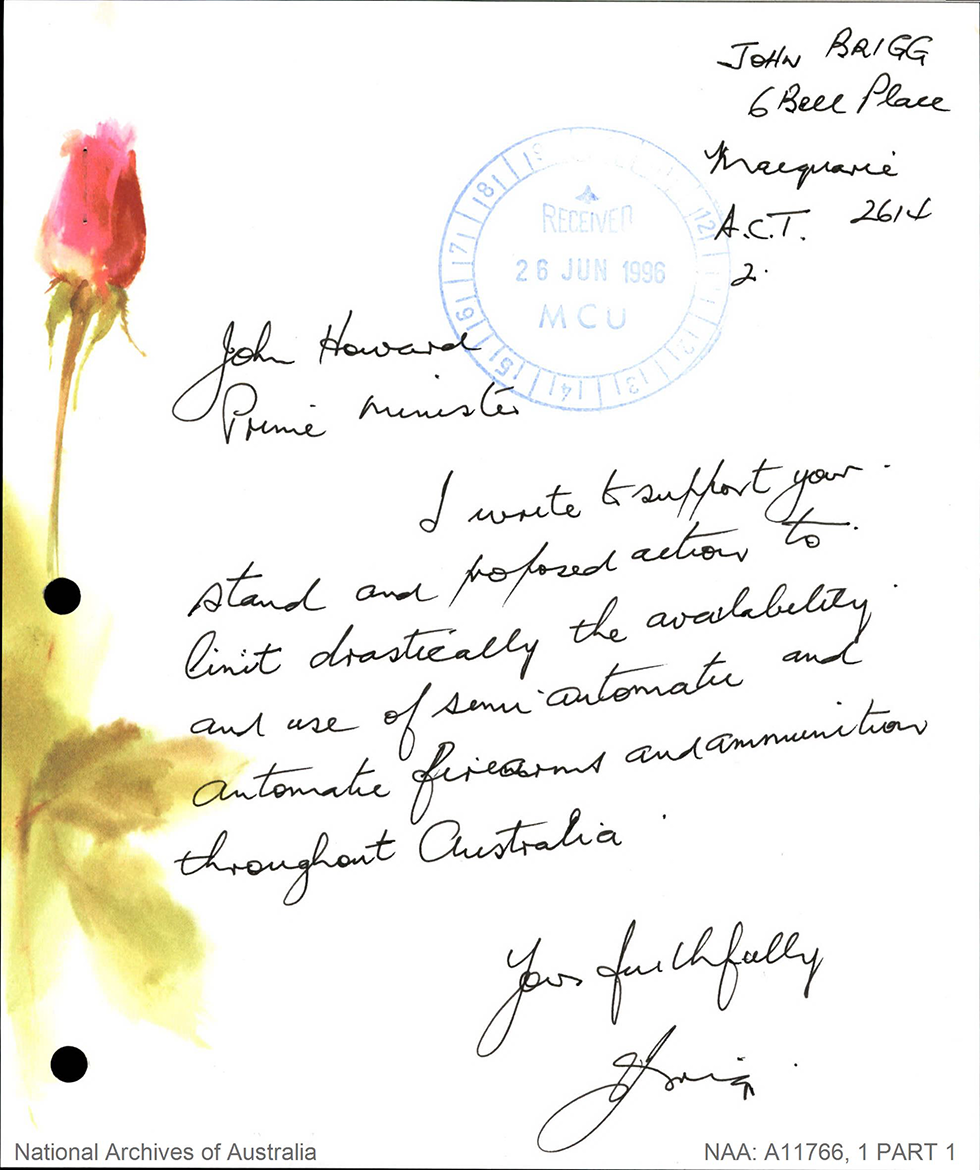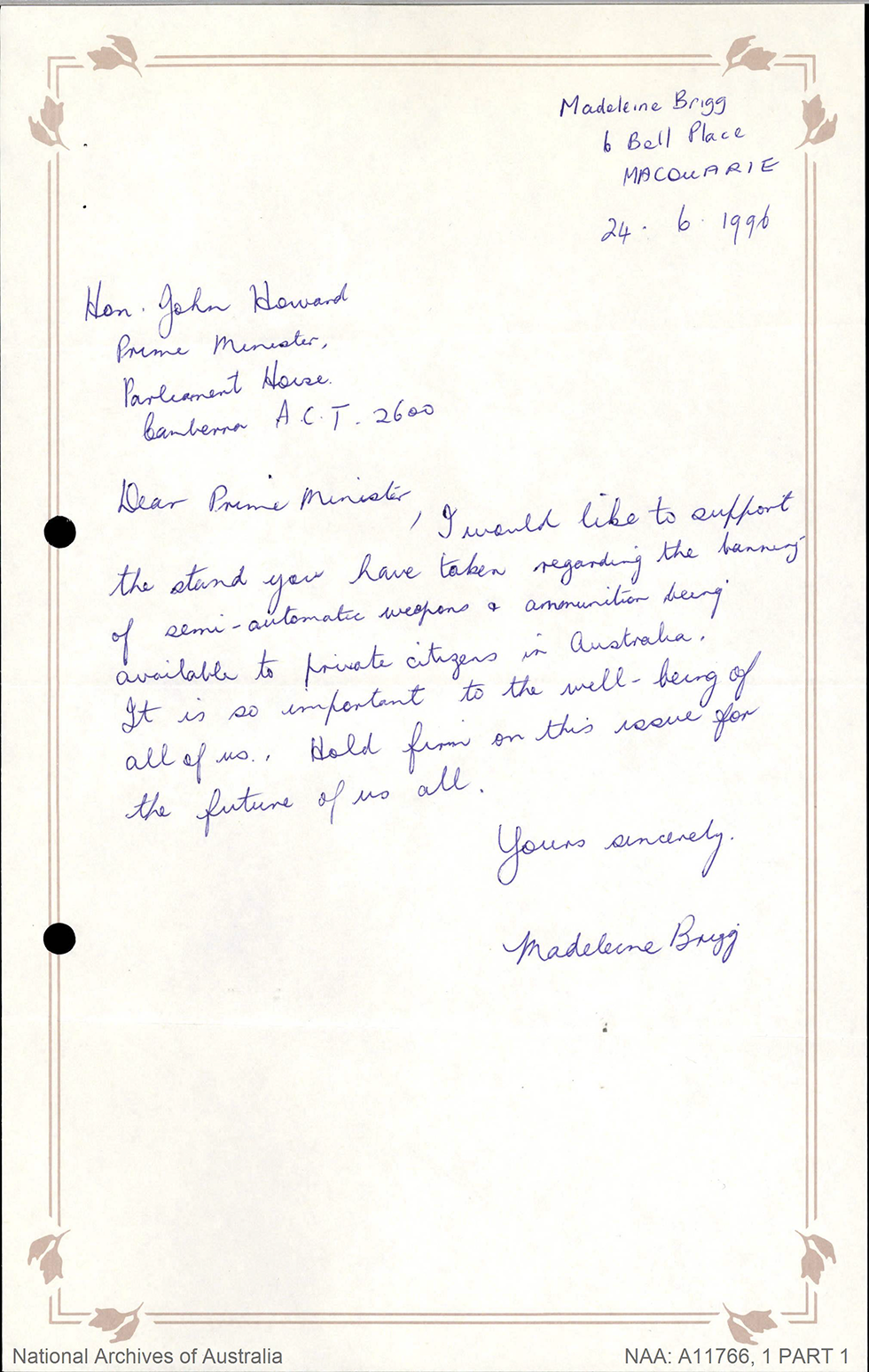

Aboriginal and Torres Strait Islander people should be aware that the National Archives' website and collection contain the names, images and voices of people who have died.
Some records include terms and views that are not appropriate today. They reflect the period in which they were created and are not the views of the National Archives.



[Page 1.]
[Handwritten letter written in black pen on decorative letter paper. Decorative letter paper includes the image of a singular, pinkish-red rose bud with a stem emerging from a haze of khaki green leaves, which are blurry, as if rendered in watercolour. The page has two holes punched in the paper]
JOHN BRIGG
6 Beel Place
Macquarie
A.C.T 2614
2.
[Round stamp printed with blue ink. The border of the stamp includes the numbers 1 through to 12. The centre of the stamp reads ‘RECEIVED 26 JUN 1996 MCU’.]
John Howard
Prime Minister
I write to support your stand and proposed action to limit drastically the availability and use of semi automatic and automatic firearms and ammunition throughout Australia.
Yours faithfully
[signature.]
[Page 2.]
[Handwritten letter written in blue pen on decorative letter paper. Decorative letter paper includes a light brown border consisting of two lines with two sets of brown leaves in each corner. The left side of the page has two holes punched in the paper.]
Madeleine Brigg
6 Bell Place
MACQUARIE
24. 6. 1996
Hon. John Howard
Prime Minister,
Parliament House
Canberra A.C.T. 2600
Dear Prime Minister,
I would like to support the stand you have taken regarding the banning of semi-automatic weapons +[and] ammunition being available to private citizens in Australia. It is so important to the well-being of all of us. Hold firm on this issue for the future of us all.
Yours sincerely.
Madeline Brigg
These are two handwritten letters written by an Australian couple in 1996 to prime minister John Howard. They wrote them to express support for John Howard’s efforts to strengthen firearm laws in Australia following the Port Arthur massacre.
The Port Arthur massacre occurred on 28 April 1996 at the historic site of Port Arthur in Tasmania. A lone gunman killed 35 people and injured many others using semiautomatic firearms.
At the time of the Port Arthur massacre, firearm laws varied considerably across Australian states and territories. The Port Arthur gunman owned three firearms, including one he purchased from a newspaper advertisement, despite never holding a gun licence.
Following the Port Arthur massacre, prime minister John Howard vowed to act quickly to reform and strengthen gun laws nationwide. This endeavour would require co-operation across the federation, because responsibility for gun laws sits primarily with the states.
At an emergency meeting held by Howard in Canberra 12 days after the massacre, an historic agreement – known as the National Firearms Agreement (NFA) – was reached between relevant state and territory police ministers.
The National Firearms Agreement received considerable public attention. Although a majority of Australians were in support of the NFA, many recreational shooters and farmers believed that their ability to own certain firearms should not be restricted because of one individual's murderous actions.
A number of pro-gun rallies were held across the country, particularly in regional areas. John Howard attended some of these rallies personally to explain the proposed laws to disgruntled members of the public. He was famously photographed wearing a bullet-proof vest while addressing the crowd at a pro-gun rally in the Victorian town of Sale.
Despite this vocal opposition, a majority of Australians believed stricter gun laws would protect the community from future acts of senseless violence. Citizens in favour of the NFA also sought to be heard by the prime minister, as this record illustrates.
All state and territory parliaments created laws to enact changes agreed to in the NFA. These changes included:
In 1996-1997, the Australian Government also initiated a gun buyback scheme and amnesty that paid approximately $304 million to gun owners across Australia in exchange for their firearms. Around 600 000 weapons – representing about 1/3 of all privately owned guns in Australia – were surrendered to the government and later destroyed.
There has been a significant reduction in gun violence in Australia since these sweeping reforms to gun laws were made in 1996. Australians continue to make their voices heard on the issue of gun control nationally and internationally today.
Learn how to interpret primary sources, use our collection and more.
